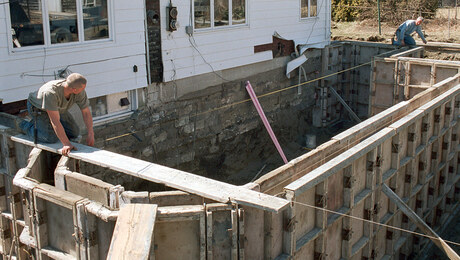I have a question about attic insulation. Did anyone ever make or use any asbestos based wall/attic insulation? My sister inlaw called me yesterday concerned and worried that she has asbestos in her late 50’s era attic. I told her I was relatively sure that asbestos was not used but i’d look into it for her. Anybody know about this?
Discussion Forum
Discussion Forum
Up Next
Video Shorts
Featured Story

There are a number of ways to achieve a level foundation and mudsill.
Featured Video
How to Install Cable Rail Around Wood-Post CornersHighlights
"I have learned so much thanks to the searchable articles on the FHB website. I can confidently say that I expect to be a life-long subscriber." - M.K.

















Replies
Some mineral wool insulation contained asbestos. Most of it did not. There is no way of knowing without testing it.
If it's cellulose or fiberglass, you are ok.
Yes. It's called Vermiculite. It often contains some asbestos, but not by design. Vermiculite is a mineral that is mined and then processed by heating it. It kind of puffs up like popcorn, when heated, and it makes a good loose insulation. The biggest vermiculite mine in the U.S. was just a couple of miles from the biggest asbestos mine in the US. They were both operated by the same company, and the equipment was probably moved around from mine to mine. Both materials were processed in the same facility in town (Libby, Montana) and there was some cross-contamination. So most Vermiculite has some trace amounts of asbestos in it. Your sister's might not. Tests can be performed, but since the asbestos isn't uniformly distributed throughout the insulation, they might be misleading.
There are millions of homes in the United States with Vermiculite insulation. Millions of people are NOT dying of asbestos caused lung cancer. These houses are perfectly safe to live in. As long as you don't go up into the attic and play in the stuff, there is no danger. If there is going to be some remodeling, your sister should be careful and take a common sense approach to containing the material.
The EPA has this to say: http://www.epa.gov/asbestos/verm.html
and some others have this to say: http://www.vermiculite.net/
(Edited the post to fix a link.)
Edited 10/25/2004 5:21 pm ET by Glatt
wow glatt, thanks!, i learned alot
-->
measure once
scribble several lines
spend some time figuring out wich scribble
cut the wrong line
get mad
Glatt has given you some good information and sources.I would point out in passing that the vermiculite.net site is from a vermiculite company, and I think it goes a bit too far in making its case, although I don't disagree with its conclusions.FWIW, bottom line, if I had exposed vermiculite insulation in my attic, I'd cover it over with either FG batts or a breathable lining (to prevent accidental mixing in case of future work) and blown cellulose or blown fiberglass.That's mainly because if you can see the vermiculite, you don't have enough insulation by today's standards.Note that everyone has their own way of evaluating risk, and different people will reach different conclusions as to degrees of risk for just about every human activity.The main risk I see from vermiculite insulation is that it might possibly, but very far from definitely, affect resale in the future.If I was house buying, and had the choice of two otherwise identical houses at the same price and one had vermiculite and one didn't, I'd go for the one without.OTOH, if I really liked a house and it happened to have it, I wouldn't let it stop me from buying the house.That is a personal opinion based on the information available today.FWIW, as a home inspector, I've been following this issue for several years.I don't know about yours, but my church isn't a hotel for the holy, it's a hospital for sinners
Sojourners: Christians for Justice and Peace